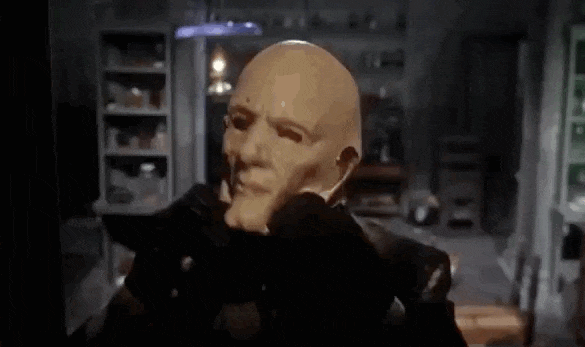While not a Peter Cushing film, the Horror of Frankenstein is included here because it is part of the Hammer films Frankenstein series and while Cushing didn't appear in the film, it's of interest as an example of how Hammer tried to experiment with a winning formula . . . and failed.
CAST:
Ralph Bates (Victor
Frankenstein), Dave Prowse (The Monster), Kate O’Mara (Alys), Veronica
Carlson (Elizabeth Heiss), Graham James (Wilhelm Kastner), Dennis Price
(Grave Robber), Bernard Archer (Professor Heiss), Jon Finch (Lieutenant
Henry Becker)
PRODUCTION:
Director/Producer –
Jimmy Sangster, Screenplay – Jimmy Sangster & Jeremy Burnham,
Photography – Moray Grant, Music – Malcolm Williamson, Make up – Tom
Smith, Art Direction – Scott MacGregor. Production Company – Hammer/EMI.
SYNOPSIS:
VICTOR FRANKENSTEIN, a
cold, arrogant and womanising genius, is angry when his father forbids
him to continue his anatomical experiments. He sabotages his father’s
shotgun, causing him to be killed. Inheriting the family fortune, Victor
uses this to enter med school in Vienna but is forced to return home
when he gets the dean’s daughter pregnant. There he sets up laboratory,
starting a series of experiments into the revivification of the dead.
Eventually, he builds up a composite body from human parts, which he
brings to life.
COMMENTARY:
THE HORROR OF FRANKENSTEIN was the fifth film in Hammer’s Frankenstein series. By
1970, Hammer had regurgitated most of their monster themes several times
over. The Horror of Frankenstein came at the point Hammer were starting
to inject new blood into their product. The influence of the younger
generation was making itself felt and Hammer were casting younger stars,
recruiting young directors, not to mention placing an open emphasis on
sexuality in films.
WITH THE HORROR OF FRANKENSTEIN, screenwriter Jimmy Sangster was brought back to rewrite
his script for The Curse of Frankenstein (1957), which started the
series and Hammer’s reputation as a horror industry leader off thirteen
years before, while he was also allowed to make his début as director.
The role of Frankenstein was given a facelift and Peter Cushing was
unceremoniously dumped from the role in favour of Ralph Bates whom
Hammer were grooming as a new horror star at the time.
PUBLICITY STILLS were shot on the set with Ralph Bates and Peter Cushing shaking hands to announce the change. The future of the Frankenstein series seemed to be heading in a new direction ... only The Horror of Frankenstein was a disaster and the Hammer Frankenstein series failed to go in any new directions.
THE SADDEST THING about The Horror of Frankenstein is that it comes from Jimmy Sangster who did such a fine job in tuning the script for Hammer’s The Curse of Frankenstein. There is such a gulf between The Curse of Frankenstein and the loose remake here in terms of quality with Sangster seeming to understand so little about what made the original work that the success of Curse can only be placed down to director Terence Fisher.
The other Hammer Frankenstein films are:– The Curse of Frankenstein (1957), The Revenge of Frankenstein (1958), The Evil of Frankenstein (1964), Frankenstein Created Woman (1967), Frankenstein Must Be Destroyed (1969) and Frankenstein and the Monster from Hell (1973).
REVIEW: Richard Scheib
IMAGES: Marcus Brooks
PUBLICITY STILLS were shot on the set with Ralph Bates and Peter Cushing shaking hands to announce the change. The future of the Frankenstein series seemed to be heading in a new direction ... only The Horror of Frankenstein was a disaster and the Hammer Frankenstein series failed to go in any new directions.
THE HORROR OF FRANKENSTEIN starts in with a promising sense of black humour. However,
the opening tapers off and Jimmy Sangster thereafter seems uncertain
whether he is delivering parody or straight melodrama. The effort turns
out dismally where all that Sangster ends up doing is weakly echoing The
Curse of Frankenstein in a plot that seems more interested in
Frankenstein’s sexual dalliances than his medical obsessions. The sets
seem flatly lit. Dave Prowse, the bodybuilder who later played Darth
Vader in Star Wars (1977) and sequels, turns the monster into a mindless
brute. The best thing about the film is Ralph Bates’s cold and arrogant
Frankenstein but the rest of the show is dreary and dull.
THE SADDEST THING about The Horror of Frankenstein is that it comes from Jimmy Sangster who did such a fine job in tuning the script for Hammer’s The Curse of Frankenstein. There is such a gulf between The Curse of Frankenstein and the loose remake here in terms of quality with Sangster seeming to understand so little about what made the original work that the success of Curse can only be placed down to director Terence Fisher.
The other Hammer Frankenstein films are:– The Curse of Frankenstein (1957), The Revenge of Frankenstein (1958), The Evil of Frankenstein (1964), Frankenstein Created Woman (1967), Frankenstein Must Be Destroyed (1969) and Frankenstein and the Monster from Hell (1973).
REVIEW: Richard Scheib
IMAGES: Marcus Brooks
#FRANKENSTEINFRIDAY EVERY FRIDAY HERE AT OUR WEBSITE AND AT
OUR FACEBOOKFAN PAGE COME JOIN US!


















































